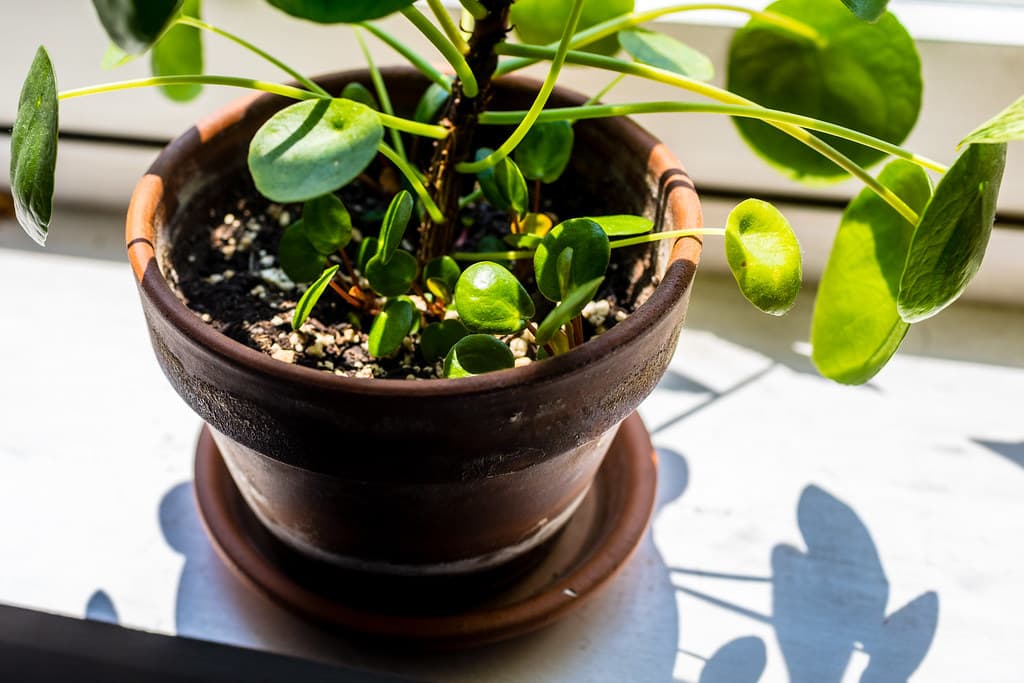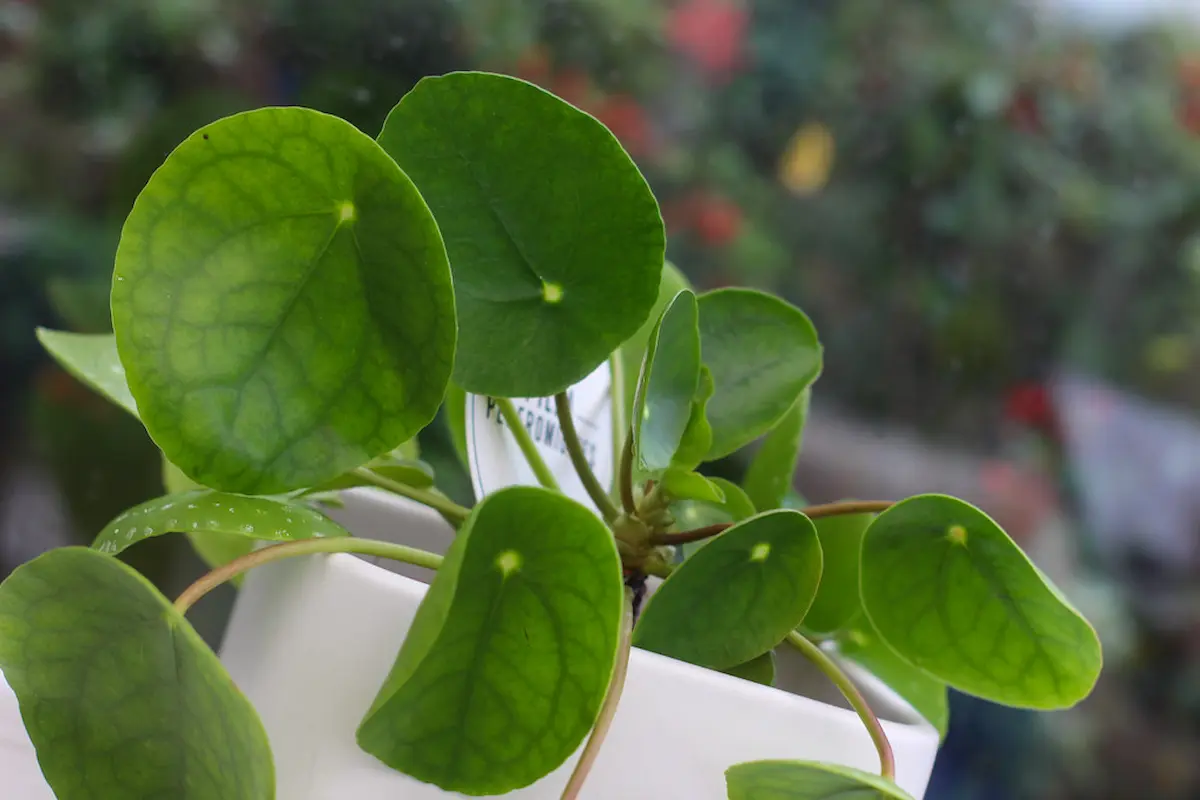Your cart is currently empty!
Grey Goldenrod
Grey Goldenrod flower has clusters of literally hundreds of flowers, called florets, only a few millimeters in diameter. Florets are grouped.
Your cart is currently empty!
The pilea, also popular as the Chinese money plant, is a beautiful treasure. It’s cheerful and aesthetically appealing, and quite easy to care for. The plant grows rapidly before producing tiny kids, so you can share it with your friends! I can’t help but grin each time I see mine. Their unusual shape sets them apart from other simple sites.
It became widespread worldwide after people circulated its “pups,” and now it’s found its way to North America. I’m a history buff, so this is fascinating to me. You can trace it back to when it was first brought and freely shared by the individual who planted it.
Botanical Name: Pilea peperomioides
Also Called: Chinese Mondkay plant, UFO plant, pancake plant
En français: Piléa
Sun / Shade:
Water: Moderate but don’t overwater
Soil:
Care:
The pilea is not only beautiful, but it’s also quite simple to maintain. It’s also very robust! Here are some suggestions for caring for the pilea:
I notice that repotting a pilea helps growth—giving it some wiggle room will encourage the pups to spread out. Use a container with a fairly small drainage hole to avoid root rot. If you have an earthenware pot that you love but doesn’t have a spot, these drill bits are perfect for creating one. I adore the dependable terra cotta pot because it is practical and basic. The terracotta is wonderful since it is composed of natural clay, allowing for greater ventilation (unlike a PVC container).
Don’t get me wrong, a plastic pot or a glazed pot with a drainage hole may be used; however, if you water your pilea carelessly, the terracotta will be more forgiving since it dries out faster. If you have a beautiful container, insert your terracotta pot inside. I’ll remove the terracotta pot from the ornamental one for watering and let it drain fully, then replace it in the ornamental pool. Pour some tiny pebbles on the bottom of your pilea at a depth of 1 inch to aid drainage. The stones help drain water and prevent your plant from succumbing to root rot. I prefer a high-quality, well-draining potting mix for my soil.
If you don’t have access to a local greenhouse, get some at your local hardware shop. My mix includes some finely ground sand. The sand assists in drying out the plant somewhat quicker during our humid months (in southern Missouri).

You must water your pilea moderately, but do not overwater it. They wish to dry out between waterings and don’t want to stay wet. I stick my finger in the soil to see if the pot is still heavy with moisture from the previous watering.
If the soil starts to feel dry when touched, I water it again. Allow for drying between waterings, but ensure it does not become bone dry (although it is quite resilient and can endure it). I water mine once a week.
If the plant feels damp after checking it for a few days, I’ll wait a few more days before revisiting it. A friend sent me a photo of her pilea drooping significantly. We figured it needed to be watered after seeing that it had dried out somewhat. It had gotten dry too long!
If left alone, the pilea will communicate with you and let you know what it wants and when it requires it. Just be attentive. I went to a local greenhouse for advice on how to kill the pilea, and they informed me that overwatering was one of the few methods.
Never allow your pilea to sit in water when you water it. Once you’ve watered it, check to see if there’s any extra water in the bottom dish. If the dirt stays wet/soggy for an extended period, the roots decay, and the plant dies. I’m a watering addict. It’s taken me a fairly long time to get over my desire to “nurture” (i.e., water) the plant since I am prone to overwatering.
The pilea is ecstatic about the light! It just needs enough indirect sunshine. What exactly does it imply? Putting your pilea on your front porch with the sun beaming down on it would be direct light, and it will burn.
Keep them indoors near a bright window to ensure a good start. I keep mine in the most light-drenched room in my house, and they adore it. My mother had a pilea on her dining room table that got lengthy and leggy—it had an extremely long middle stem with just a few branches (it was low light).
It was grasping for the light and appeared on its last legs. It went outside under her covered porch, where it gets a lot of indirect sunlight and is growing again. It’s no longer skinny or tall! Once you figure out what they need, they adapt in an instant.
I ran out of window space in my house, so I put a few of my pileas outside under a covered porch. They appear to enjoy the summer air and are flourishing! When the temperature drops, I’ll return them indoors as soon as possible.
Another suggestion is that once the pilea senses the light, it will begin to lean towards it. It’s amusing to see them reaching for the window like they’re desperate to get out! I turn them each time I water them, which helps to keep them straight and level. Dusting the leaves helps to increase light exposure. To maintain the leaves healthily and glossy, use a wet cloth to wipe off any dust lightly.
The speed with which pilea plants generate new young is one of the best features! Little infants will emerge from the soil or develop on the stem (close to the dirt) as it matures. The pups are tiny newborns. They originate from the root system and rise out of the ground on the top, like puppies.
When the pups have finished developing, you may chop them off the mother plant or allow them to grow. Allow the pups to develop, and a complete mother plant is created (which is gorgeous!). It’s amazing how fast and full they’ll get if you don’t make any cuts. I also have a pilea that I will grow and share with friends, specifically for this purpose.
I generally wait until my plant is at least three inches tall before trimming it. An X-Acto knife is my favorite instrument, but any sharp tool will do. Before cutting into your pilea, give your pruning or propagation knife a good wash. I’ve heard that you should consider trimming or propagating your plant like real surgery and that you should always clean your instruments beforehand. When you’re ready to cut off a pup’s roots, remember that the root system is rather fragile.
It is unnecessary to pull or tug on the pup. Make a shallow incision in the dirt where the pup meets it, and it should rise naturally. Stick the bud in water or put it in the soil after removing it. Water is my preferred technique because I enjoy seeing the roots penetrate through the glass. Stick your tiny glass or vase in indirect but bright light for optimum results. Once you see some roots sprouting, you can plant them in a pot.

If you want to grow your pilea more quickly, fertilize it in the spring and summer. There’s some confusion over fertilizer use, but I like to apply a 10-10-10 mix. A liquid crop nutrient is preferable to me since it is equally distributed throughout the plant. I put a little fertilizer in the watering can when I water. Check the instructions on the back of your fertilizer and follow them carefully.
Hello, my name is Emma, editor, and writer for plantscraze.com. As a professional writer working in the plant care niche, my love for plants and plant care increases daily. In return, this has helped me improve my mental health as well as my professional life.
Logging in to comment gives you more features, but it is not required.
Grey Goldenrod flower has clusters of literally hundreds of flowers, called florets, only a few millimeters in diameter. Florets are grouped.
of art! Create a beautiful plant and pot display with easy steps for all skill levels.
Here are 8 different plants which attract hummingbirds, with details of their origin, life cycle, and appearance.
Sharing a love of plants and the outdoors led them to escape to the country to allow the space to explore their passion for plants.
GardeningCalendar.ca gets some funding from advertisers. If you click on links and advertisements at no cost to you, the site may receive a small commission that helps fund its operation.
© 2025 J&S Calendars Ltd.
[…] it comes to providing the right environment for your Pilea plant, lighting and temperature are two crucial factors to consider. To keep your […]